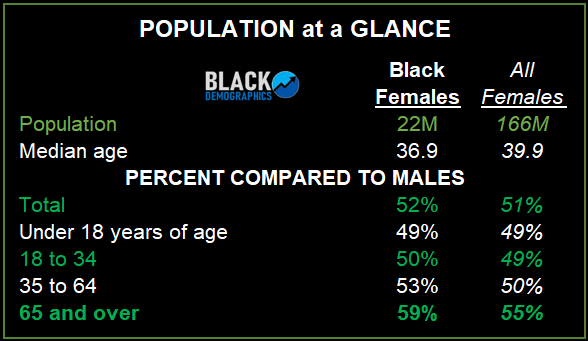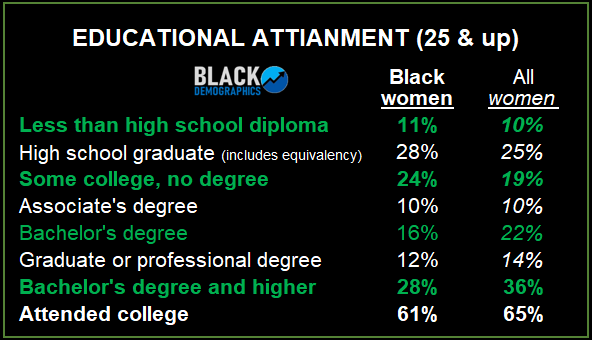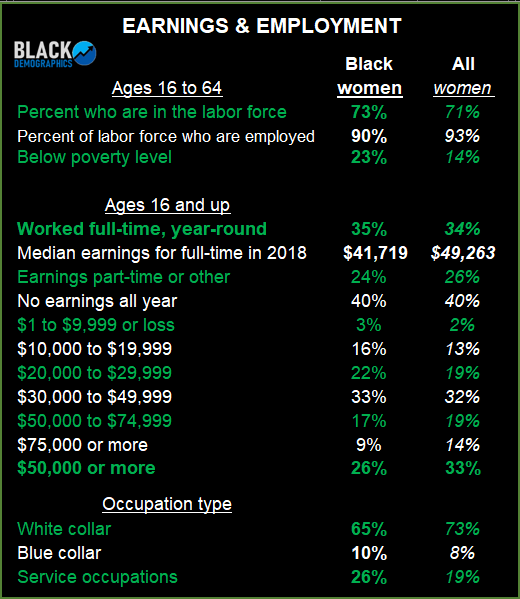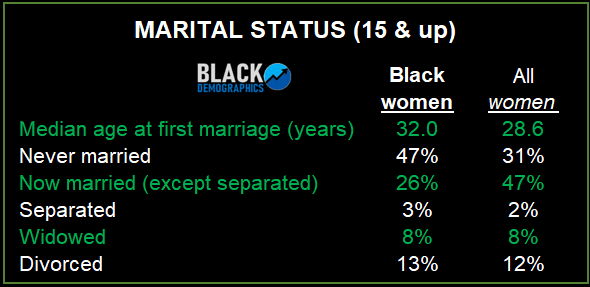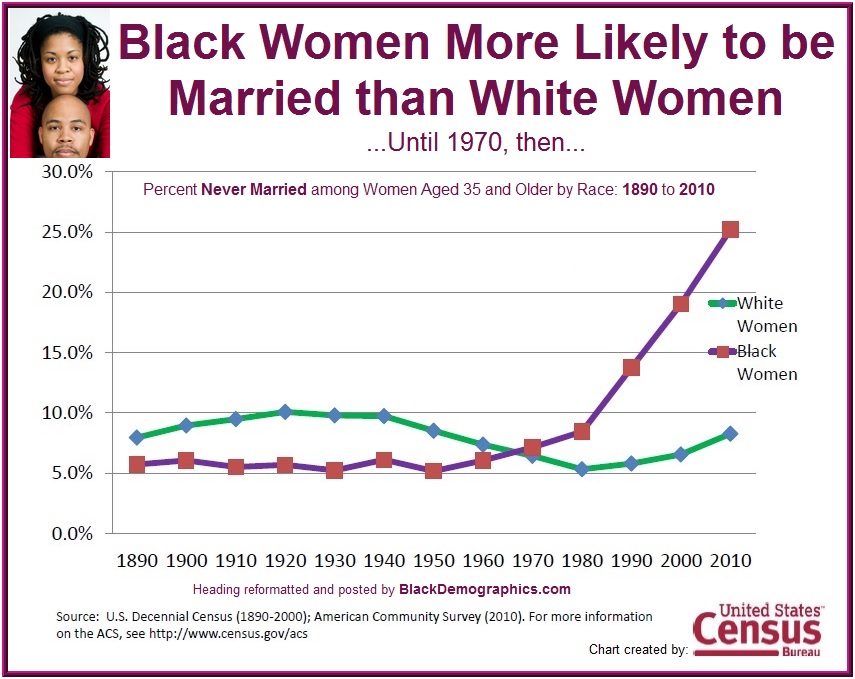Black Women: Statistics
Understanding the Black Female Population in the U.S.
What the Numbers Say:
- How Many Are There? – In 2021, there were about 21.5 million Black women in the United States. This is a little over half (52%) of all Black people in the country. Black men made up the other 48%.
- Age Matters: Black women are, on average, younger than women of all races in America. The average age for Black women is 36 years, while it’s 40 years for all women in the country.
- Young Girls: Among the Black female population, about 49% are girls under 18 years old. This is similar to the percentage of young girls in the overall female population of the U.S.
- Growing Older: As people get older in the Black community, there are more women than men. This is partly because Black men tend to have shorter lifespans compared to men of other races. Also, women generally live longer than men.
More Insights on Population Trends…
Education Levels of Black Women in the U.S.
(note that numbers may not add up to 100% because of rounding)
Key Points:
- College Attendance: About 59% of Black women who are 25 years old or older have gone to college. But only around 35% of them have finished a college degree (like an associate’s degree). This is compared to 63% of all women in the U.S. who went to college, and 42% of them finished their degree.
- Degree Comparison:
- Bachelor’s Degrees and Higher: About 28% of Black women have a bachelor’s degree or a higher degree. For all women in the U.S., it’s 36%.
- Associates Degree: Around 10% of Black women have an associate’s degree, which is almost the same as for all women in America (9%).
- High School Graduates: There are slightly more Black women (29%) who finished high school but didn’t go for higher education, compared to all women (26%).
- Comparing with Black Men: Black women are doing better than Black men in getting college degrees. Around 28% of Black women have at least a bachelor’s degree, while for Black men, it’s 22%.
Employment of African American Women in the U.S. (2021)
Main Points:
- Labor Force Participation: About 73% of African American women between the ages of 16 and 64 were part of the labor force. This is a bit higher than the rate for all women, which is 71%. Being part of the labor force means they were either working or looking for a job.
- Who Isn’t Working?: Women not in the labor force might be full-time students, disabled, or not looking for work for various reasons.
- Earnings: The average earnings for African American women who worked full time all year were $41,719. This is less than the average for all women, which was $49,263.
- No Earnings: About 40% of African American women (16 years and older) had no earnings in 2021, which is the same as the rate for all women in this age group.
- Types of Jobs:
- White Collar Jobs: These are jobs like management, business, computers, legal, and education. Only 65% of working African American women had white collar jobs, compared to 73% of all women.
- Blue Collar Jobs: About 10% of working African American women are in blue collar jobs, like construction, maintenance, or transportation.
- Service Jobs: These include healthcare support, food preparation, and similar roles. African American women are more likely to have service jobs compared to all women.
Even though Black women are over-represented in the workforce they still have a higher unemployment rate than ‘all women’, 10% to 6% respectively. All of these factors help explain the higher poverty rate for Black women (29%) than ‘all women’ at 17 percent.
RELATIONSHIPS
Relationship Status of Black Women in the U.S.
Understanding the Numbers:
- Never Married: About 47% of Black women have never been married. This is a big difference when compared to all women in America, of whom only 31% have never been married.
- Currently Married: Only 26% of Black women are currently married. This is quite different from all women in America, where 47% are currently married.
- Separated or Divorced:
- Separated: Black women are slightly more likely to be separated from their spouses, with a rate of 3%, compared to 2% for all women.
- Divorced: The rates are closer when it comes to being divorced. About 13% of Black women are divorced, which is just a bit higher than the 12% rate for all women.
Black women are less likely to be married than Black men. As a matter of fact there are about 364,000 more Black men who are married than Black women even though Black women are 51% of the Black population. While an overwhelming percentage of Black women are married to Black men (94%), about 86% of Black men are married to Black women.
More about Marriage…
OTHER CHARACTERISTICS
Black women are the head of 27% of all Black households in 2018 which is more than twice the rate for ‘all women’ at 12 percent. These are households defined by the U.S. Census Bureau as having a female head and no spouse present. Only 37% of Black women who gave birth were married which is almost the opposite for ‘all women’ at 66%. These are some of the issues factor into a much higher poverty rate of 24% for Black women compared to a 14% poverty rate for all women.
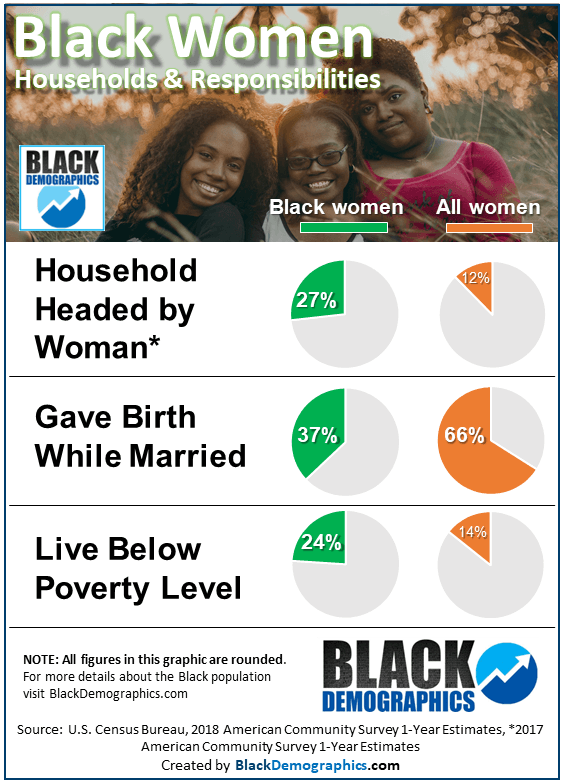
These additional responsibilities may also explain why Black women are slightly over-represented in the workforce compared to all women.


